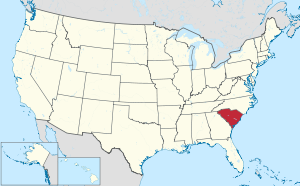Clarendon County | |
|---|---|
 Clarendon County Courthouse | |
 Location within the U.S. state of South Carolina | |
 South Carolina's location within the U.S. | |
| Coordinates: 33°40′N 80°13′W / 33.66°N 80.22°W | |
| Country | |
| State | |
| Founded | 1785 |
| Named for | Edward Hyde, 1st Earl of Clarendon |
| Seat | Manning |
| Largest community | Manning |
| Area | |
• Total | 695.67 sq mi (1,801.8 km2) |
| • Land | 607.21 sq mi (1,572.7 km2) |
| • Water | 88.46 sq mi (229.1 km2) 12.72% |
| Population (2020) | |
• Total | 31,144 |
• Estimate (2023) | 31,004 |
| • Density | 51.29/sq mi (19.80/km2) |
| Time zone | UTC−5 (Eastern) |
| • Summer (DST) | UTC−4 (EDT) |
| Congressional district | 6th |
| Website | www |
Clarendon County is a county located below the fall line in the Coastal Plain region of U.S. state of South Carolina. As of the 2020 census, its population was 31,144.[1] Its county seat is Manning.[2]
This area was developed for lumber and mills, including textile mills. Clarendon County boasts one of the largest man-made lakes in the United States, Lake Marion, completed in 1941 as a New Deal project. It was planned as part of a national rural electrification initiative. Since the late 20th century, the dam's generation of hydroelectric power has also stimulated economic development and industry in the region.
The South Carolina state legislature established racial segregation of public facilities by state law in the late 19th century. During the Civil Rights Movement, Clarendon County was the site of the Briggs v. Elliott trial challenging segregation of public schools. This case was one of five combined with what came to be known as Brown v. Board of Education, under which the United States Supreme Court ruled in 1954 that racial segregation of public schools was unconstitutional.
- ^ Cite error: The named reference
2020CensusQuickFactswas invoked but never defined (see the help page). - ^ "Find a County". National Association of Counties. Archived from the original on May 31, 2011. Retrieved June 7, 2011.
